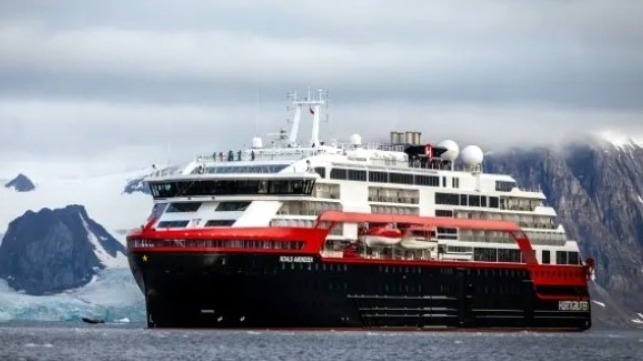Norwegian Maritime Authority Releases Hurtigruten COVID-19 Audit

The Norwegian Maritime Authority has released the results of its audit looking into Hurtigruten and the events surrounding the COVID-19 incident that happened in late July involving one of the company’s cruise ships. The audit, which is the first of several investigations and independent audits, highlights one observation and seven deviations for which Hurtigruten is required to submit a plan to correct the discrepancies.
Fulfilling its promise to provide full transparency, Hurtigruten issued both a statement and published the results of the audit on its website in Norwegian. The company acknowledges the findings, and while noting the authority says that Hurtigruten has been responsive since the incident, promises to take action to address the issues.
“What the Norwegian Maritime Authority points out is serious and shows that we must improve,” says CEO Daniel Skjeldam in Hurtigruten’s written response. “This is the first important step on the road to getting all the answers on the table and getting all aspects of our operation improved. We are now awaiting the external investigation, which will give us even more answers and a broader basis for the work we have ahead of us.”
Among the key findings of the Norwegian Maritime Authority’s audit are failures in several areas of safety policy, adherence to code, and implementation of prepared protocols. The authority starts with a discussion that Hurtigruten did not conduct a risk assessment before starting its expedition cruises in July. Given the challenges of managing and operating during the pandemic the authority says, and also points out that Hurtigruten’s procedures also indicated, that a risk assessment should have been performed.
The incident under review began during the last week of July on the company’s second expedition cruise aboard the Roald Amundsen. Crew members aboard the ship reported not feeling well and were put in isolation while onshore Norwegian authorities informed Hurtigruten that a passenger that had been aboard the ship the prior week tested positive for the virus. Hurtigruten made its first public statements on Friday, July 31 acknowledging that crew members had tested positive for COVID-19, but only made the statement after the passengers had disembarked and some had begun to travel from Tromso, Norway to their homes. Other passengers were still in the airport and were notified and placed in quarantine as well as given tests. In total, 29 passengers who had sailed aboard the two cruises and 42 crew members ultimately tested positive.
Looking at the specific COVID-19 incident, the audit says, “The reporting culture does not seem to have worked as it should in connection with the incident.” The audit says that it appears on July 29, two days before the ship arrived in Tromso, employees of the shipping company suspected COVID-19 infections on board but it was not reported further in the organization. They note that management said they had not received an official report that there was a suspicion, but the audit calls into question adherence to the reporting process and safety culture.
The audit also says as early as July 21 crew members were ill and in the ship’s hospital. Although none of them had been diagnosed with COVID-19, the audit still finds that the ship failed to log it and no suspicion of COVID-19 was reported. The company’s protocol said that in the event of a suspicion or discovery of COVID-19 the ship’s doctor must follow the reporting routines and inform the ship’s captain who in turn shall inform the company through operation management without delay. “It emerged in the interviews,” the report says, “that notification routines for suspicion of COVID-19 infection were not followed on board the Roald Amundsen.”
The audit believes that the reporting lines and lines of responsibility in relation to certain procedures were unclear to some people. During the audit, they say that some individuals were unclear on who and when they should be reporting incidents.
Further, the Norwegian Maritime Authority says that it believes the emergency preparedness did not work as planned once the incident was confirmed. The emergency organization was not implemented immediately on July 31, but the authority says Hurtigruten worked well in the aftermath of the incident.
“It is worrying that the Norwegian Maritime Directorate questions whether the safety culture was well enough incorporated into the organization. Shortly after the COVID-19 outbreak on MS Roald Amundsen, we stepped up our efforts to ensure routines and better follow-up of these,” says Asta Lassesen, who became acting operations director and acting general manager of Hurtigruten Cruise in August after the company asked another executive to relinquish his roles during the investigation. Lassesen now leads the operations of Hurtigruten and is overseeing the company’s efforts to enhance its programs.
The Norwegian Maritime Authority has said that Hurtigruten must submit a plan to correct the discrepancies by September 21. The authority will review and approve the plan and the steps should be implemented to correct the discrepancies by November 24.
This will be the first of several reports looking at the events surrounding the COVID-19 outbreak tied to the cruise ship. Hurtigruten’s board has also retained DNV and Wiersholm, one of Norway’s largest law firms, to conduct an external investigation.
